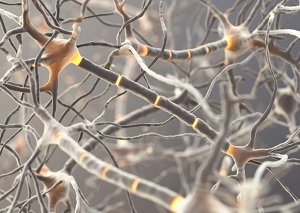Sympathetic Nervous System
 The sympathetic nervous system, sometimes abbreviated as SNS, is a component of the autonomic nervous system—the portion of the nervous system largely concerned with regulating automatic functions such as heart rate and digestion. Although commonly regarded as the portion of the nervous system that instigates the fight or flight response, the sympathetic nervous system also fulfills a constant role in regulating homeostasis—the maintenance of relatively consistent internal states.
The sympathetic nervous system, sometimes abbreviated as SNS, is a component of the autonomic nervous system—the portion of the nervous system largely concerned with regulating automatic functions such as heart rate and digestion. Although commonly regarded as the portion of the nervous system that instigates the fight or flight response, the sympathetic nervous system also fulfills a constant role in regulating homeostasis—the maintenance of relatively consistent internal states.
Sympathetic Nervous System Organization
The sympathetic nervous system originates within the spinal cord, and thus many of its functions are automatic and unconscious; neurons in the spinal cord typically regulate functions that do not require conscious thought. The neurons of the sympathetic nervous system are located toward the middle of the spine, and are attached to long axons. These axons, in turn, are connected to chain ganglia on either side of the spine. Peripheral sympathetic neurons are located here and carry signals to and from neurons throughout the body, including to the organs.
Functions of the Sympathetic Nervous System
The sympathetic nervous system’s two primary functions are regulating homeostasis and instigating the fight or flight response. During times of stress, the sympathetic nervous system can dilate the pupils, elevate the heart rate, increase sweating, and elevate the blood pressure. The neurotransmitters adrenaline and noradrenaline are heavily implicated in the fight or flight response.
During normal bodily functions, the SNS maintains homeostasis by maintaining a relatively consistent heart rate and blood pressure. People suffering from prolonged stress may experience constant activation of the sympathetic nervous system. This can lead to health problems such as depressed immunity and prolonged illness. It may also contribute to the development of mental health conditions such as anxiety, depression, posttraumatic stress, and hyper-reactivity.
References:
- Sympathetic nervous system. (n.d.). ScienceDaily. Retrieved from http://www.sciencedaily.com/articles/s/sympathetic_nervous_system.htm
- Sympathetic nervous system. (n.d.). Sympathetic Nervous System Info Site. Retrieved from http://www.sympatheticnervoussystem.net/
Last Updated: 08-26-2015
- 3 comments
- Leave a Comment
Dawit
October 5th, 2016 at 12:59 PManxiety is it not entirely related to our conscious or unconscious state of mind?
“desire to do something, typically accompanied by unease” When once want or desire to do something he MUST think and thinking is 100% mind not brain. both Parasympathetic and Sympathetic are 100% physical means a bundle of connective tissue or nerves has to work based on a human body environment, where ever one situated could be in Amazon jungle or in a lovely paradise, but the ‘person’ has to use the body for different functions. And NO worries why addressing the physical part which is the brain of, a person doesn’t solve the problem of anxiety or many other emotional challenges we facing today. Please response and teach me I’m open to learn.
DawitBetty B
January 6th, 2018 at 4:26 PMWondering how to BEST treat c-ptsd
Zaheer
October 27th, 2021 at 1:49 AMThere is evidence when someone take SSRI his or her mind think better, mind is not something beyond nerve and connective tissue it actually arise from there in proper working environment.
Leave a Comment
By commenting you acknowledge acceptance of GoodTherapy.org's Terms and Conditions of Use.
